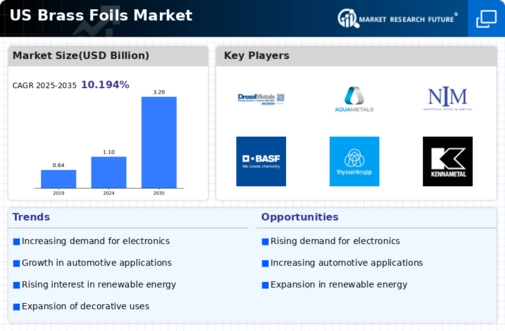The brass foils market is characterized by a competitive landscape that is increasingly shaped by innovation, sustainability, and strategic partnerships. Key players such as Mundra Brass (US), Olin Brass (US), and KME Germany AG (Germany) are actively pursuing strategies that emphasize technological advancements and operational efficiencies. Mundra Brass (US) has focused on enhancing its product offerings through the integration of advanced manufacturing techniques, which appears to position the company favorably in a market that values quality and precision. Meanwhile, Olin Brass (US) has been expanding its footprint through strategic acquisitions, thereby consolidating its market presence and enhancing its supply chain capabilities. KME Germany AG (Germany) has also been investing in digital transformation initiatives, which may provide a competitive edge in terms of operational agility and customer responsiveness.
The business tactics employed by these companies reflect a broader trend towards localizing manufacturing and optimizing supply chains to mitigate risks and enhance responsiveness to market demands. The competitive structure of the brass foils market is moderately fragmented, with several key players exerting influence over pricing and product availability. This fragmentation allows for a diverse range of offerings, yet it also compels companies to differentiate themselves through innovation and customer service.
In November 2025, Mundra Brass (US) announced the launch of a new line of eco-friendly brass foils, which underscores the company's commitment to sustainability and aligns with growing consumer preferences for environmentally responsible products. This strategic move not only enhances Mundra Brass's product portfolio but also positions the company as a leader in sustainable manufacturing practices within the industry. In October 2025, Olin Brass (US) completed the acquisition of a regional competitor, which is likely to bolster its market share and streamline its operations, thereby enhancing its competitive positioning in the brass foils market.
In September 2025, KME Germany AG (Germany) unveiled a new digital platform aimed at improving customer engagement and order processing efficiency. This initiative reflects a broader trend towards digitalization in the industry, suggesting that KME is keen on leveraging technology to enhance customer experience and operational efficiency. Such advancements may prove crucial as the market continues to evolve towards more integrated and responsive supply chain models.
As of December 2025, the competitive trends in the brass foils market are increasingly defined by digitalization, sustainability, and the integration of advanced technologies such as AI. Strategic alliances among key players are shaping the landscape, fostering innovation and collaborative efforts to address market challenges. The shift from price-based competition to a focus on technological differentiation and supply chain reliability is becoming evident. Companies that can effectively leverage these trends are likely to emerge as leaders in the brass foils market, driving future growth and innovation.





















Leave a Comment